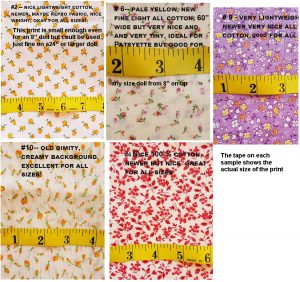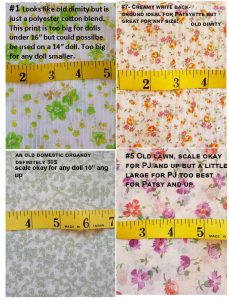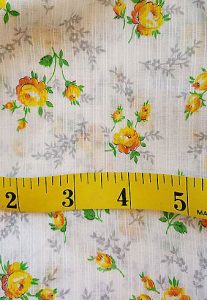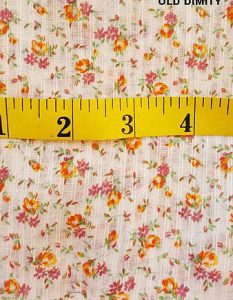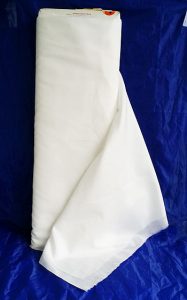Here is another picture of more fabrics suitable in scale for doll clothes. In case you missed the last post, if it says something is suitable for PJ it means the 11″ Patsy Junior of the Effanbee Patsy family. They are only examples, it is the height of the doll you are sewing for that matters when choosing the right print. Click on the picture to enlarge and see the scale of the print better. feel free to leave questions or comments below.
More About Print Size for Dolls
I will do two posts on this, as I have too many pictures for one post. The picture shows the scale ( size) of the print with the tape across it. The scale involves not just the size of the flowers or print, but the distance between the flowers. If you remember that a bodice for a 14″ doll, for example, is only about 3-4″ from sleeve seam to sleeve seam, you can see that if the major design or flowers are 2″ or more apart– the bodice will look pretty blank, and the skirt won’t have very many flowers either. For an 8 or 9″ doll, you need a pretty small print to get more than one item on the bodice! Check out the picture, each fabric has comments printed on it. The dolls referred to on some of the prints are Patsy Family dolls, Patsyette is 9″ and PJ–Patsy Junior—is 11″ There will be another set of fabrics in the next post. Please feel free to leave comments or questions. You will NOT recieve unwanted emails– comments are answered on the Blog, and your information is confidential.
Silk Ribbons for Your Antique Doll Dresses
I never use anything but pure silk ribbon on doll dresses for dolls made before 1940– unless I get lucky and find some 1930s rayon double faced rayon ribbon, which I haven’t found for years now.
There is nothing worse that wonderful vintage fabrics being ruined because they are trimmed with polyester— whether it is ribbons or lace, it just takes away the quality and period correctness of the dress.
Silk ribbon is, however, expensive for top quality double faced ribbon, although you can buy cheaper single faced silk ribbon elsewhere for cheaper. I have a wonderful source for the silk ribbon I use. She carries the best colors and you could not ask for better service. She also carries french and other cotton laces, if you are in need of just a small amount to finish your doll dress. She has been so helpful to me for several years I highly recommend her site to everyone– and she also carries other things, in case you are wanting or making heirloom baby things, christening dresses, etc.
Her shipping is more than reasonable too. For your silk ribbon needs, go to Simply Wonderful Things. Tell her JoAnn Morgan sent you!
Please leave questions or comments below, you will NOT be spammed with emails! We hate sites that do that!
Silks for Heirloom Doll Dresses
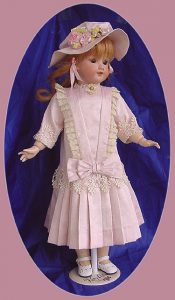 Silk is always a choice for dresses for antique dolls– whether dolls from the 1700s or from the 1930s– there were dolls that came in silk dresses. These were the top of the line dolls, as even then, silk was expensive. Though expensive, silk was for many years the only choice if you didn’t want a wool or cotton dress. Fine ladies’ dresses and the fancy dresses of little rich girls were made of silk, so the finest quality dolls representing either also wore silks.
Silk is always a choice for dresses for antique dolls– whether dolls from the 1700s or from the 1930s– there were dolls that came in silk dresses. These were the top of the line dolls, as even then, silk was expensive. Though expensive, silk was for many years the only choice if you didn’t want a wool or cotton dress. Fine ladies’ dresses and the fancy dresses of little rich girls were made of silk, so the finest quality dolls representing either also wore silks.
In sewing heirloom doll dresses in silk, it is important to know there are many varieties and weights of silk. Some is heavy and used for home decor. Some so delicate it will almost float to the floor if you drop it. Silk weight is usually described as momme, or MM. Here is a description of that:
“What is momme weight? In simplest terms, momme weight describes the weight of 100 yards of silk, 45 inches wide, in pounds. So, if a fabric is listed with a momme weight of 8mm, it means that 100 yards of the fabric weighs 8 pounds. Many silk dresses and other silk clothing items will be around 8mm in weight. Higher quality silks tend to be 14, 15 or 16mm or higher. Most of LovaSilk bedding is 19mm or 19 pounds in weight per 100 meters.”
If you buy silk, that still doesn’t tell you much until you feel the different weights in your hands. To help you out–plain china silk, which you have heard of, is usually very thin and soft and is 5 mm weight. If it is just a little more substantial, it would be 8 mm. that is not too horrible to work with for doll dresses— but 10 is easier and still very delicate.
For doll dresses, I frankly don’t like to work with any silk but dupioni, which is not a smooth but a slubbed silk. This too can vary in weight so a good idea to request samples if you can’t feel it. I have made mostly dresses for antique china or bisque head dolls with silk, but also made dresses for Cissy and the composition Patsy doll. Patsy did have some original factory dresses in silk, but the ones I have see were plain weave 8mm china silk. Click here to see an antique style dupioni silk dress, and here to see a dupioni silk Cissy dress, Click here to see an antique style dress of embroidered dupioni silk. The picture heading this post shows Patsy in her silk dress and the one accompanying this text shows an antique style silk dress and hat I made.
Feel free to leave questions or comments below.
More About Cotton Fabrics for Heirloom Doll Dresses
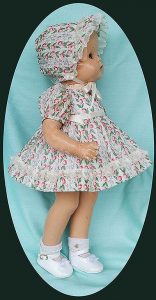 I don’t want to bore you with post after post of types of cotton– there are many more than the more commonly used ones I have talked about. The important thing about cotton fabrics for heirloom doll dresses is the weight and pattern scale. The fabric should always be very light to light weight, and the scale of any patterns on it should be appropriate for doll size garments. For example, if there are flowers on the dress, when you cut out a bodice for, say, a 14″ doll, there should preferably be several flowers on the bodice– not just one big one or worse yet, none. Click here to see an example of flowers on the bodice in a very appropriate small scale print– and here to see one that is barely small enough to work “just okay” on the same size doll. By just okay I mean the print is barely small enough, because if you will notice the larger green flower is so far apart there is only one on the bodice, and while there is one on one sleeve there is none on the other sleeve. Because of the additional smaller flowers on the print it works okay– but it would have been nicer had the print been smaller so the large green flowers would not be so far apart that there could have been at least two on the bodice. So always be aware of scale when choosing prints for doll dresses. I will be answering any questions posted on the blog, so I am going to move on from the cotton fabrics for now.
I don’t want to bore you with post after post of types of cotton– there are many more than the more commonly used ones I have talked about. The important thing about cotton fabrics for heirloom doll dresses is the weight and pattern scale. The fabric should always be very light to light weight, and the scale of any patterns on it should be appropriate for doll size garments. For example, if there are flowers on the dress, when you cut out a bodice for, say, a 14″ doll, there should preferably be several flowers on the bodice– not just one big one or worse yet, none. Click here to see an example of flowers on the bodice in a very appropriate small scale print– and here to see one that is barely small enough to work “just okay” on the same size doll. By just okay I mean the print is barely small enough, because if you will notice the larger green flower is so far apart there is only one on the bodice, and while there is one on one sleeve there is none on the other sleeve. Because of the additional smaller flowers on the print it works okay– but it would have been nicer had the print been smaller so the large green flowers would not be so far apart that there could have been at least two on the bodice. So always be aware of scale when choosing prints for doll dresses. I will be answering any questions posted on the blog, so I am going to move on from the cotton fabrics for now.
Leave questions or comments below. You will NOT be spammed or get a bunch of emails!
Button or Snap Foot for Your Machine
This foot is another that helps me cut the time on sewing so I can afford to sell dresses at the prices I do. I know a lot of people sell doll dresses for a few dollars on the internet and especially on eBay– and I am often asked “why are your dresses so expensive?” The reason is the fine detail and expert work and finishing as well as the top quality fabrics and embellishments. If I didn’t have all the tools to help cut the time required to make heirloom quality dresses, I would have to charge a great deal more for them.
This foot, used for sewing on snaps and little buttons is available for I think almost any sewing machine that does zig zag sewing with adjustable zig-zag width. Just be sure to buy it for your brand of machine.
In a later blog I will show a video of how to use this foot.
Leave questions or comments below. You will NOT be spammed or get a bunch of emails!
Dimity Fabric– What is it
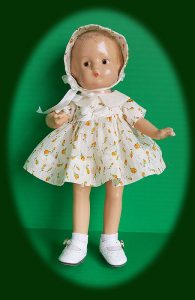 Dimity is another fabric that has been made since the 1800s— it is the weave that gives it its name. Most of the dimity made long ago was wool. The dimity we see from the 1900s is usually cotton, and certainly doll dresses made of dimity between 1900 and 1960 are 100% cotton.
Dimity is another fabric that has been made since the 1800s— it is the weave that gives it its name. Most of the dimity made long ago was wool. The dimity we see from the 1900s is usually cotton, and certainly doll dresses made of dimity between 1900 and 1960 are 100% cotton.
Regular dimity has a woven line through it. Window Pane dimity has a checkered weave pattern giving it the look of little squares. Since 1960, fabric companies keep trying to duplicate the old cotton dimity, making it with cotton plus polyester, but it is not the same, if you handled both you could easily see the difference. If you are buying dimity fabric for heirloom doll dresses, just make certain it is 100% cotton, and you can’t go wrong.
You will find if you look for it on eBay you will pay a premium price, because there is no fabric that makes more charming heirloom dresses! Unhappily, uneducated fabric sellers tend to think any fabric with any kind of line in it is “dimity”, so you have to be careful. One sure clue is the width: old dimity will be NO WIDER THAN 36′ WITH BOTH SELVAGE EDGES, and frequently will be even narrower– from the 1920s it may be only 28″ wide with both selvages. When I am shopping for it I will not consider any that is wider than 35″, with both selvage edges, then I KNOW it is old. I highlight the both selvages because if they are missing, you may have a polyester fabric that with the selvages was originally much wider, and the edges have simply been trimmed off to make a narrower fabric. I see this happening a lot on eBay since real dimity from before 1940 commands very high prices. The dresses in pictures accompanying this post are dimity dresses, click here to see more pictures. All of the dresses in the pictures with this post are 1930s vintage fabric.
Here are pictures of two different 1930s dimity fabrics: (click pictures to enlarge)
Leave questions or comments below. You will NOT be spammed or get a bunch of emails!
Fabric for Heirloom Doll Dresses–Taffeta
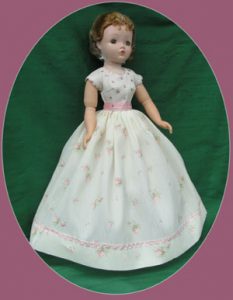 Rayon taffeta was a popular fabric for “fancy” clothes, first gaining popularity in the 1920s and during the depression, because it could resemble silk but not cost nearly as much. Since silk was not washable either, the fact you couldn’t wash rayon didn’t deter people from using it.
Rayon taffeta was a popular fabric for “fancy” clothes, first gaining popularity in the 1920s and during the depression, because it could resemble silk but not cost nearly as much. Since silk was not washable either, the fact you couldn’t wash rayon didn’t deter people from using it.
More “young lady” dolls were popular from the late 1930s and through 1940s, like Madame Alexander Portrait ladies, bridesmaids, and dolls representing entertainers, dressed in formals that were often made of assorted types of rayon, from rayon taffeta to rayon chiffon. ( during this era, women’s silk stockings were replaced with rayon stockings! Much cheaper than silk-but looked just as good.) In doll size, the light weight, rustley rayon taffeta was perfect for brides, bridesmaids, and prom dresses— and inexpensive. Many of those dresses are lost because they were ruined by washing them– who thinks of dry cleaning a doll dress?? But then, if we are making heirloom doll dresses, the people making and using them know the dolls will just be for display and the dresses won’t need to be washed, so it is okay to use this lovely fabric for fancy formals, bride dresses and such.
Your only problem in using it is to make sure it is very light weight and you cut it with pinking shears and allow 3/8″ seams. There are lots of different kinds of rayon taffeta, here is a vintage taffeta brocade dress and here is dress of new rayon taffeta for Cissy doll, just click the links to see the samples.
Leave questions or comments below. You will NOT be spammed or get a bunch of emails!
Doll Dress Embellishments
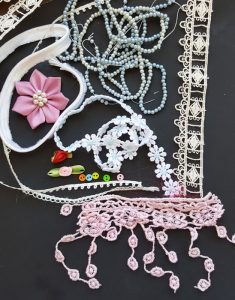 There are so many embellishments that it would take way too much time and space to list them all, so I am hoping a few samples will give you the idea, as well as ideas of how to choose and use different types. I am using the same picture to point out different things you might use. I may offer more suggestions in the future on “tips and tricks”.
There are so many embellishments that it would take way too much time and space to list them all, so I am hoping a few samples will give you the idea, as well as ideas of how to choose and use different types. I am using the same picture to point out different things you might use. I may offer more suggestions in the future on “tips and tricks”.
There are tiny rosebuds, beads, satin ribbon rosettes,piping, and braids– from the larger daisy braid to the tiny looped rayon braids (some shown in this picture). Rick-rack, a specific and familiar form of braid, is a favorite embellishment for old dolls. Rick rack has actually been used since the 1800s ( on people clothes) although the type of use has changed somewhat. In early years it was used to “finish” fabric edges so they would not fray, in place of hemming the edges, and having the double purpose of also providing a decorative finish. In the 20th century rick rack has mostly been used for embellishment— decorative purposes. The lovely different sizes available now are great on doll dresses. When choosing, the largest you should use on doll dresses is the 1/4″ baby rick rack. anything else becomes too coarse and out of proportion, unless you are making a dress for a life-size doll.
Small or even tiny buttons add a charming touch to many things. There are doll size rhinestones and studs. Bows should always be done in either double-faced satin or taffeta ribbons for the best results. Artificial flowers, formerly of a more paperish material as well as real silk, are now happily available in “silk” flowers of most any size you need. I used some 1950s vintage flowers and some newer “silk” flowers on this bride dress, shown here on a Toni doll. Click on the close up pictures to see the flower detail better.
Heirloom Doll Dress– Cotton Lawn
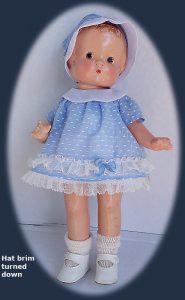 Lawn is another cotton favorite for doll dresses for dolls made before 1960, but even more appropriate for those made before 1950. Lawn is a lightweight cloth, crisper than voile but not as crisp as organdy. Lawn can range from gauzy or sheer to an almost opaque effect .. It is a great fabric for doll clothes! The prints are charming and it is fairly easy to find a print that is small enough in scale to work for even quite small dolls. (We will talk about pattern scale more in another post.) Lawn was especially popular for doll clothes in the 1920s and 1930s, and it was also known as “Nainsook” so if you see that in old catalog ads for dolls, you will know what kind of fabric the dress is! Lawn used to be made of linen but is now made mostly if not entirely of cotton.
Lawn is another cotton favorite for doll dresses for dolls made before 1960, but even more appropriate for those made before 1950. Lawn is a lightweight cloth, crisper than voile but not as crisp as organdy. Lawn can range from gauzy or sheer to an almost opaque effect .. It is a great fabric for doll clothes! The prints are charming and it is fairly easy to find a print that is small enough in scale to work for even quite small dolls. (We will talk about pattern scale more in another post.) Lawn was especially popular for doll clothes in the 1920s and 1930s, and it was also known as “Nainsook” so if you see that in old catalog ads for dolls, you will know what kind of fabric the dress is! Lawn used to be made of linen but is now made mostly if not entirely of cotton.
Lawn makes lovely doll dresses, but again, the new lawn is usually not sized and needs to be sized to have a little crispness to it for the best effects. It is usually easy to sew, even for little dolls. Click here to see a dress of printed lawn. The blue dress shown with this post is also lawn, click here to see more.
Leave questions or comments below. You will NOT be spammed or get a bunch of emails!
Cotton Organdy for Heirloom Doll Dresses
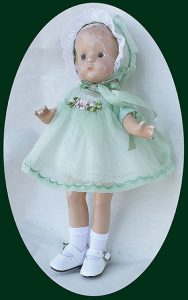 Many of you will not know what it means that something is organdy. Cotton organdy is still made and used, but because it has to be starched and ironed if it is washed, it pretty much faded out of popular fashion by the mid-1950s when the new “No Iron” fabrics came into more common use. No one wanted to iron clothes anymore! Nylon organdy was made to try and keep that market– and I indeed used some to make a dress for my oldest daughter– but it still needed some pressing, and if your iron was a bit too warm– it melted. For that reason it was never popular. I can’t tell you how many garments, curtains, etc. I touched with an iron a little too warm and ruined– the melted place could not be made to look right again.
Many of you will not know what it means that something is organdy. Cotton organdy is still made and used, but because it has to be starched and ironed if it is washed, it pretty much faded out of popular fashion by the mid-1950s when the new “No Iron” fabrics came into more common use. No one wanted to iron clothes anymore! Nylon organdy was made to try and keep that market– and I indeed used some to make a dress for my oldest daughter– but it still needed some pressing, and if your iron was a bit too warm– it melted. For that reason it was never popular. I can’t tell you how many garments, curtains, etc. I touched with an iron a little too warm and ruined– the melted place could not be made to look right again.
But cotton organdy was very commonly used on doll clothes (as well as for people clothes, curtains, and many other things) for nearly a hundred years. It is delicate enough to make even tiny clothes, and does not fray when cut. It makes the most elegant ruffles! Click here to see a sample of an organdy baby dress and bonnet with ruffles made with 1930s embroidered cotton organdy. There were many grades and type of cotton organdy too, from very thin and poor domestic organdy, used for cheap dolls during the depression years, to the very finest Swiss organdy, which was used for the expensive dolls. Organdy of any grade is not easy to sew– but the results are worth the effort! The better grades are easier to sew than the cheapest, which is quit thin with a loose weave while fine organdy has a tight weave and is sheer but not flimsy. Here is a picture of a dress made in modern cotton organdy that was made in India — click here
The finest of the best, Swiss organdy, is very expensive and is still imported by Spechler-Vogel of New York. They are wholesale only, but there are stores that carry it, such as Fabric Depot in Portland, Oregon.
Leave questions or comments below. You will NOT be spammed or get a bunch of emails!
Lace for Doll Dresses
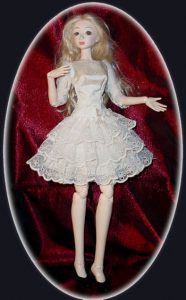
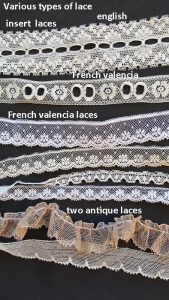 This is just a small sample of the laces available for use on heirloom quality doll dresses. All these are of course cotton laces. If you are not familiar with insert lace, (the ones with the holes in it) you run a ribbon through the holes for a very nice effect. I use this a lot on dresses for very antique bisque head dolls.
This is just a small sample of the laces available for use on heirloom quality doll dresses. All these are of course cotton laces. If you are not familiar with insert lace, (the ones with the holes in it) you run a ribbon through the holes for a very nice effect. I use this a lot on dresses for very antique bisque head dolls.
There are many more kinds of lace—if you are not acquainted with lace, be sure to take the time to learn about it. If you browse the dresses on my website you will see many different types of lace used in many different ways. You can use wide lace to form a complete skirt on a doll or narrow delicate lace for the trim on a small dress.
French Valencia lace has been used at least a couple of hundred years and probably much longer. It is still made today and expensive but worth the price if you are making doll dresses– there is not a lace on the market that is better, but some English laces are as good. All are cotton of course. There is a lot of cotton lace coming out of China now– they are quick to see what people want. However, all cotton lace is not equal so before buying a lot of it, be sure to sample it.
Really fine English and French laces have a “draw string” in the top, which you can carefully pull to make delicate ruffles in the lace. On doll dresses, if you want to make quality ones, never NEVER use the fat heavy cotton laces– use only the delicate ones of the correct scale.
Leave questions or comments below. You will NOT be spammed or get a bunch of emails!
Lace, Braid, Buttons and Bows
 No dress is complete without trims and embellishments. I will go into individual ones, but for general explanation, trims include anything you put on the dress to add to it to make it something besides just the plain fabric.
No dress is complete without trims and embellishments. I will go into individual ones, but for general explanation, trims include anything you put on the dress to add to it to make it something besides just the plain fabric.
Lace and rick-rack are two of the most common trims, but there are many more. Click the links in the posts and in this one to see dresses with samples of what I am writing about.
Embellishments are little things you ad to give a dress the “finished” look. This would be like decorative buttons, beads, ribbons and bows, added in addition to or instead of trims.
Because there are so many different types, please read the separate posts for those you might be interested in trying or using.
Leave questions or comments below. You will NOT be spammed or get a bunch of emails!
More About Cotton For Doll Dresses–Voile
Voile
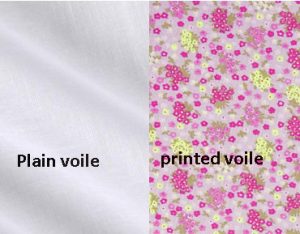 Broadcloth is only one of many cottons suitable for doll dresses. The next few posts will be about cotton in other weaves. The types are too numerous for one post, and anyone hoping to make heirloom doll dresses should have a good working knowledge of them. You can’t bake a cake without the right ingredients, and you can’t make beautiful doll dresses if you have no idea what materials you need.
Broadcloth is only one of many cottons suitable for doll dresses. The next few posts will be about cotton in other weaves. The types are too numerous for one post, and anyone hoping to make heirloom doll dresses should have a good working knowledge of them. You can’t bake a cake without the right ingredients, and you can’t make beautiful doll dresses if you have no idea what materials you need.
Voile is a very lightweight fabric that is usually 100% cotton but now sometimes a blend with polyester. If you try to make dresses with the blend, you will have trouble with shape and drape. For dolls, 100% cotton is a must for voile. It is loosely woven and in fact sometimes so loosely woven it will fray with small seams like those used on doll dresses, so cutting it with pinking shears and allowing 3/8″ seams instead of 1/4″ seams is a important for easier handling.
Voile is usually so soft that to make pretty doll dresses you should add sizing– spray starch to give fabric better drape is helpful and also makes the small pieces easier to handle. I use Mary Ellen Products Best Press and spray the fabric before cutting. If I need a little more crispness I will spray it twice. This gives a great finish almost like commercial sizing.
Click here to see a dress done in a voile print, and here is another, click here
Leave questions or comments below. You will NOT be spammed or get a bunch of emails!
Fabrics for Doll Clothes- Cotton Batiste
Batiste
There are many types of cotton fabric that are all suitable and even desirable for heirloom quality doll dresses. I will go over a few of the most common you are likely to find on line or in your favorite fabric store.
Batiste (pronounced ba-teest) is one of the most popular all time favorite fabrics for doll dresses and underwear. Various weights and qualities of batiste have been around and used for literally hundreds of years! And you can choose many weights and qualities ranging from from cotton batiste so fine it has a sheen and resembles silk, to plain, utility quality like I use for underwear. (This type used to be commonly used for handkerchiefs).
In times past different qualities of batiste were used for things ranging from beautiful heirloom christening clothes for babies to lesser quality for cheap doll dresses to the finer quality again for beautiful for expensive doll dresses. Fine quality batiste can be found in in soft and beautiful colors– I like Swiss batiste the best for doll dresses. The best qualities also have a soft sheen. For both heirloom quality doll dresses and more utility use, as well as ease of sewing, your batiste choice should be 100% cotton– the blends are not appropriate for dolls made before 1960 and do not have the same softness, drape and manageability that cotton does.
The batiste in the picture is for sale in five yard lots on my website. It is plain, very slightly off-white (sometimes called ‘old white’) in a light weight, that I use for doll underwear and some baby doll and antique doll dresses. Click the links to see samples of my batiste dresses.
Leave questions or comments below. You will NOT be spammed or get a bunch of emails!
A Brief History of Fabrics for Doll Clothes.
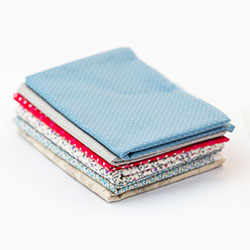 Fabrics for doll clothes will be discussed individually, but this in brief mentions the different ones and the time periods they were frequently used.
Fabrics for doll clothes will be discussed individually, but this in brief mentions the different ones and the time periods they were frequently used.
Before you can make museum quality clothing for old dolls, you have to first have a good understanding of fabric and trims. If you make a dress for a 1950s or 1940s doll out of fabric that was not even manufactured before 1960, you will not have a “museum quality” or “heirloom quality” dress regardless of how well it is sewn. And you can ruin a dress of beautiful cotton or silk by attaching polyester lace and ribbons.
Therefore, before you can start making patterns and clothes, you will need a good understanding of fabrics.
Before 1940, there were limited fabrics used for doll ( and even people) clothing. Cotton, wool, silk, linen. All these fabrics came in weights and styles from heavy and coarse to light and delicate. I at one time owned a 1980s wedding dress made of cream wool that was so fine and delicate you would never think it was wool, and likewise I have seen garments of silk that were quite heavy and not what one would think of as silk
In the late 1800s the first synthetic was made, rayon, but it was unstable and did not come into common use until it was perfected, in the early 1900s. At that time rayon was used in many forms, mostly for thing like ladies lingerie but also for fancy dresses that would have previously been made of silk, a much more expensive fabric. Because the rayon was not nearly the quality of silk, people soon would pass over garments advertised as made of rayon- so manufacturers would advertise a garment of “imitation silk” instead of rayon. You will find old catalogs describing both doll clothes and people clothes as “ imitation silk”—which means they were rayon. The rayon of the time (like real rayon fabric today) was ruined if it was washed—so it was dry clean only. It was often quite fragile and would tear easily. It also frayed easily so was not popular for home sewing. Many doll clothes between 1910 and 1950 were made of rayon, which is one reason so many “factory original” doll dresses were lost and discarded—they were fragile, frayed easily and a few times off and on in the hands of a little girl often left them limp and often torn, so they were discarded. If they were washed they were thus ruined and discarded.
In successive posts I will talk about each different fabric, it’s qualities and what is most desirable for dolls made any time before 1960. For dolls made after that, it is okay to use synthetics–or anything you wish. most of them are dressed in synthetic fabrics or blends.
Leave questions or comments below. You will NOT be spammed or get a bunch of emails!
Fabric for Heirloom Doll Dresses –Cotton Broadcloth
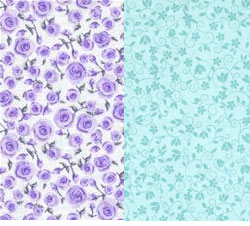 Cotton broadcloth, as such, is uniquely American– broadcloth is a type of weave that was traditionally done in wool, but in the UK they used a cotton named poplin which, when imported to the U.S., was called broadcloth for the U.S. market. It comes in many weights and from snowy white to a myriad of prints, such as those shown in the picture. It comes in many weights from very light, light, medium, heavy and heavier. I never use any weight other than very light or light weight for doll dresses, and prefer the “very light” weight. It also comes in different qualities, so you check the “feel” and weight when shopping for it. I do a lot of shopping on line for both new and old fabrics, and any time I can I will spend a few dollars extra and get a sample before I order. One of my favorite places to buy new fabrics is Fabric.com — for a number of reasons: They have rulers on their fabric pictures showing scale, ( I will talk about scale and its critical importance in doll dresses in a later post) they give you a complete description of the fabric such as weight, size, content and so on, but for a small fee you can order a sample. The sample is worth every penny– you know exactly what you are getting, and you can order as little as a half yard or order more and get a better price on most of their fabrics.
Cotton broadcloth, as such, is uniquely American– broadcloth is a type of weave that was traditionally done in wool, but in the UK they used a cotton named poplin which, when imported to the U.S., was called broadcloth for the U.S. market. It comes in many weights and from snowy white to a myriad of prints, such as those shown in the picture. It comes in many weights from very light, light, medium, heavy and heavier. I never use any weight other than very light or light weight for doll dresses, and prefer the “very light” weight. It also comes in different qualities, so you check the “feel” and weight when shopping for it. I do a lot of shopping on line for both new and old fabrics, and any time I can I will spend a few dollars extra and get a sample before I order. One of my favorite places to buy new fabrics is Fabric.com — for a number of reasons: They have rulers on their fabric pictures showing scale, ( I will talk about scale and its critical importance in doll dresses in a later post) they give you a complete description of the fabric such as weight, size, content and so on, but for a small fee you can order a sample. The sample is worth every penny– you know exactly what you are getting, and you can order as little as a half yard or order more and get a better price on most of their fabrics.
Broadcloth is one of the easiest fabrics to sew and if it is 100% cotton won’t give you trouble with fraying. You can also use a little spray starch for a little extra crispness, which is desirable for heirloom doll dresses. In the days when women would actually iron clothes, new cotton fabric came with sizing which gave the effect of light starch, a lovely crispness to the fabric. This would usually wash out and you would then have to starch the clothes if you wanted the same crispness. Now no one wants to iron anything, so fabric companies instead do everything they can to make the fabric LIMP and not only that, treat the yarns so they won’t even easily take starch. (Don’t worry about ironing doll dresses— once they are on the doll they usually stay!) Synthetic blends are almost impossible to add that touch of crispness that makes the dresses look vintage. Another reason to avoid blends, for heirloom quality dresses, if you are using any form of cotton, always use 100% cotton, never a cotton blend.
Leave questions or comments below. You will NOT be spammed or get a bunch of emails!
What Makes a Doll Antique or Vintage
Before eBay set their own ideas for what is antique or vintage, a doll to be considered vintage had to be 75 years old and to be antique had to be at least 100 years old. eBay decided an item could be called vintage if it is no longer made— even if production stopped last week— and anything older than they are must to be antique. So for the sake of clarity in my blog, a doll has to be made BEFORE 1960 to be vintage, and at least 100 years old to be referred to as “antique”. Dolls made between 1960 and 1980 are considered to be “modern collectible dolls” and those made after 1980, such as Cabbage Patch, “My Double”, “American Girl” and others, including “limited edition” dolls, are not considered, on my blog, to be any of the above. They are just used dolls. For information about one of them, run a Google search.
